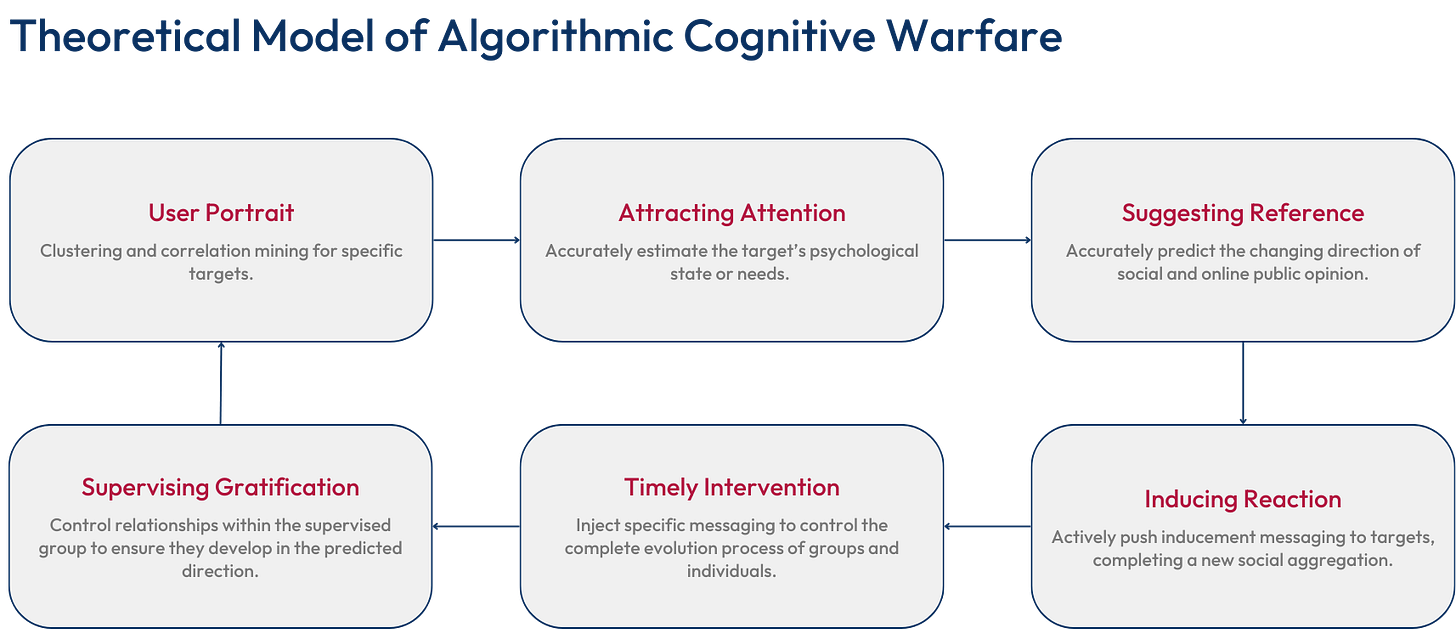Algorithmic Cognitive Warfare: The Next Frontier in China’s Quest for Global Influence
Hello, I’m Ylli Bajraktari, CEO of the Special Competitive Studies Project. In this edition of our newsletter, Libby Lange, SCSP’s Director of Intelligence, breaks down the People’s Republic of China’s emerging concept of “algorithmic cognitive warfare” and what the U.S. can do to better protect citizens from its impacts. For more on SCSP’s analysis of algorithmic cognitive warfare, read our newly released white paper, Decoding China’s AI-Powered ‘Algorithmic Cognitive Warfare’ through the button below.
📖 Genesis: Artificial Intelligence, Hope, and the Human Spirit
Our Chair, Dr. Eric Schmidt, released a new book this week on AI with Craig Mundie and the late Dr. Henry Kissinger. We’d like to share this useful resource with our readers! The book explores the complex relationship between humanity and AI, offering a unique perspective shaped by Kissinger's profound historical understanding.
✨ If you share our newsletter with your network using the link below and a new subscriber joins us, you will receive a copy of the book while supplies last! ✨
Algorithmic Cognitive Warfare: The Next Frontier in China’s Quest for Global Influence
What if a war happened all in your head – or at least partially? This is the central premise that underpins China’s People’s Liberation Army’s (PLA) concept of “cognitive warfare.” In the eyes of PLA strategists and national security thought leaders, the thoughts, information, and beliefs that reside in each individual’s “cognitive domain” shape the decisions we make and even have the power to turn the tides of battle. Following Russia’s full-scale invasion of Ukraine in 2022, Chinese military and national security scholars have begun pushing an updated concept of cognitive warfare – what they call “algorithmic cognitive warfare” – that emphasizes the capabilities powerful artificial intelligence (AI) algorithms offer to target and influence individuals at increasingly granular levels. This newsletter and accompanying white paper breaks down the phases, tactics, and goals of algorithmic cognitive warfare while also providing concrete actions the U.S. government can take to better protect the hearts and minds of U.S. citizens.

Collecting the Data
The key to China’s vision of algorithmic cognitive warfare is the massive amounts of data needed to power algorithms that can analyze individuals and understand their preferences, mental state, and relationships. Within this framework, personal traits are not just static data points, but rather a constantly shifting mosaic that can be monitored and mapped. These ambitions go beyond just collecting public social media activity or other openly available data; one Chinese paper describes how a “sea of data” can be used to understand the precise type of content most likely to influence a specific person at a specific time. To realize this vision, much of this data would need to be either purchased from data providers or stolen outright. Thus far, China has proven willing to do both.

Delivering the Payload
In a world dominated by algorithms, the most engaging content wins out. Most China-linked influence operations to date have failed in this respect. They have focused on highly ideological content that often does not resonate with broad audiences. Proponents of algorithmic cognitive warfare, however, argue for more flexibility in narratives and content to ensure maximum engagement. Early indications from both the United States and Taiwan suggest that this shift may already be happening. For example, this year, an influence campaign linked to China’s state security services created content posing as U.S. users discussing divisive political topics on multiple platforms. One video posted by the operation on TikTok was viewed over 1.5 million times. Similarly, China’s efforts to interfere in Taiwan’s January elections revolved more around narratives relevant to voters’ everyday lives than political narratives.
Building on the data collected in the first phase of an algorithmic cognitive operation, Chinese military scholars envision the ability to create content tailored to individual users, at scale. What’s more, this data collection-content delivery process acts as a feedback loop in which operators can control the outcome and gauge the effectiveness of an operation by observing the ripple effects from the content delivery itself.
Outside of data, the second important piece in the payload puzzle is the social media recommendation algorithm itself. If the PLA or other entities involved in cognitive warfare had access to a platform's algorithm and the ability to place their fingers on the scales, they could ensure the “right” content reaches the target audience at the right time. Some research shows this may already be the case. This possibility lends significant weight to concerns around China-based social media apps like TikTok.

Actions the U.S. Government Can Take
There are multiple actions the U.S. government can and should take to push back against algorithmic cognitive warfare. These include:
Enhance Analysis and Situational Awareness: Algorithmic cognitive warfare is a developing concept that will almost certainly continue to mature alongside emerging technologies like generative AI and virtual reality (VR). National security agencies will need to monitor both how these tools are discussed and how they are deployed in real-world operations.
Develop More Rapid Warning Mechanisms: A better-prepared population is a better-protected population. The U.S. intelligence community, which already plays a major role in exposing adversarial attempts to influence populations, should work to provide faster, broader warnings about this kind of activity to both policymakers and the public.
Advance Our Own Strategic Messaging: The goal of algorithmic cognitive warfare is to exploit our free and open information ecosystems to undermine democratic institutions around the world. We need to work proactively to amplify our own strategic messaging through traditional channels and online, including within China’s own information space.
Protect U.S. Citizens’ Data: The PLA cannot conduct the type of precision warfare it envisions without access to vast amounts of personal data. The U.S. government should continue its existing work to restrict the sale of citizens’ data, while also considering whether the ambitions laid out in algorithmic cognitive warfare scholarship require a reevaluation of the types of data to be restricted.
Societal resilience and cognitive security are key components of national competitiveness, and the U.S. has a wide variety of tools in its toolkit to push back against PLA encroachment into our cognitive space. A strong understanding of the “algorithmic” component of algorithmic cognitive warfare will help to future-proof our strategies to combat it. For a deeper dive into the frameworks and methods that underpin algorithmic cognitive warfare, see SCSP’s recently released white paper, “Decoding China’s AI-Powered ‘Algorithmic Cognitive Warfare.’”




The supreme art of war is to subdue the enemy without fighting.
Sun Tzu
Libby Lange's latest analysis on China. A Must Read!